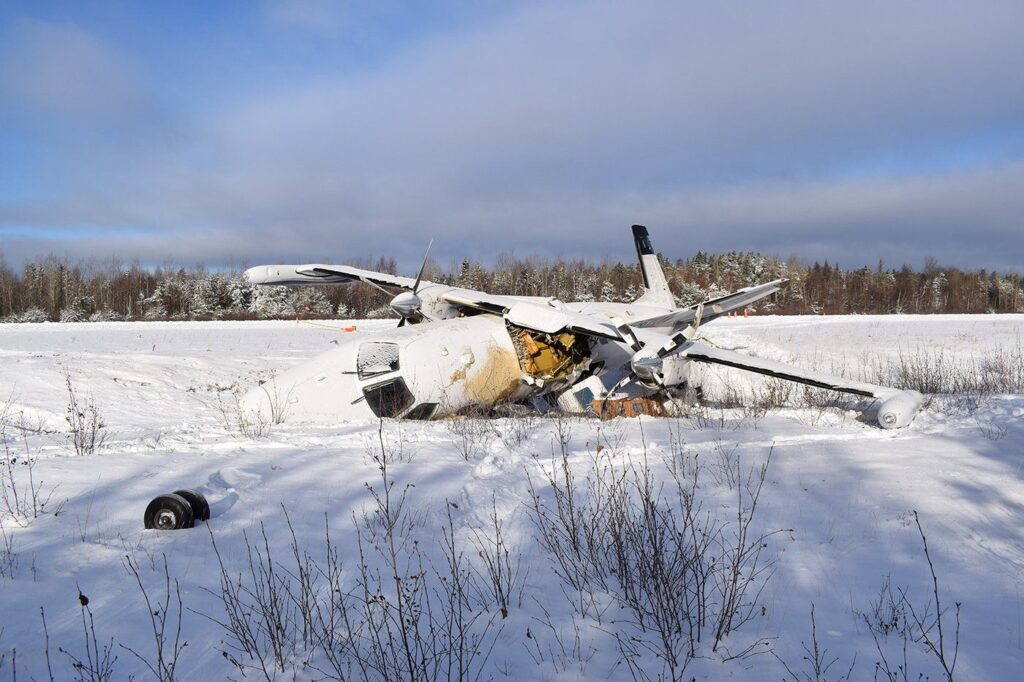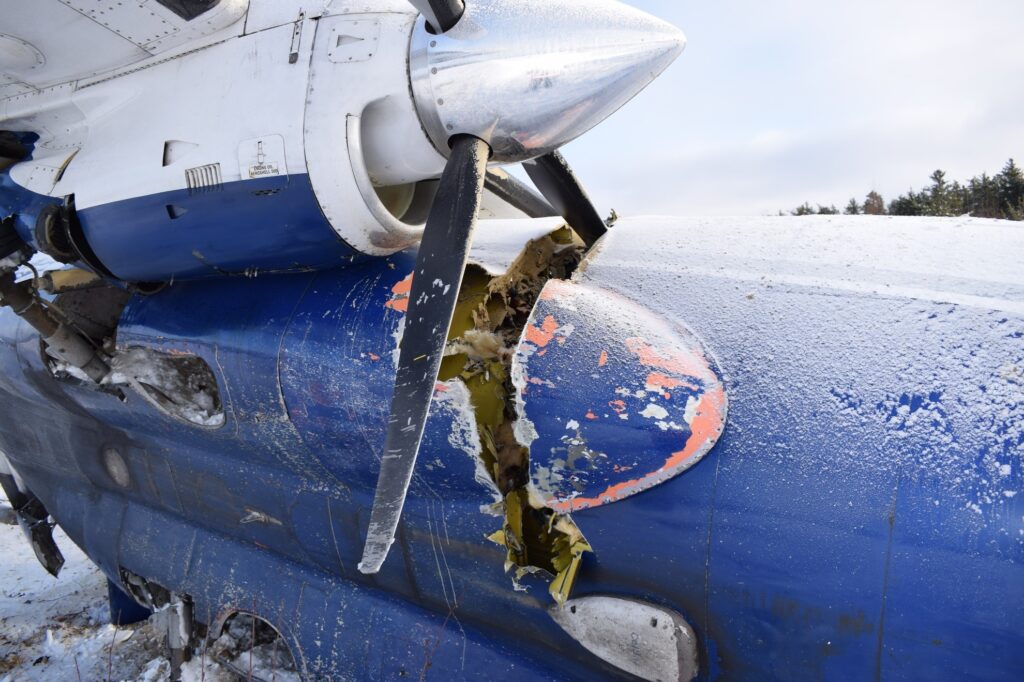
Features
Accidents
‘Miscommunication’ over snow removal contributed to Wawa plane crash
March 10, 2024 By Wings Staff
 The remains of a Mitsubishi MU-2B-60 after it slid off the Wawa Municipal Airport runway on the morning of Nov. 27 and crashed into a drainage ditch. The crew on board were only treated for minor injuries.
(Photo: Transportation Safety Board of Canada)
The remains of a Mitsubishi MU-2B-60 after it slid off the Wawa Municipal Airport runway on the morning of Nov. 27 and crashed into a drainage ditch. The crew on board were only treated for minor injuries.
(Photo: Transportation Safety Board of Canada) The Transportation Safety Board of Canada (TSB) has concluded its investigation into a Nov. 27 plane crash at Wawa Municipal Airport that resulted in minor injuries for the small crew on board.
While snowy conditions on the runway caused the Mitsubishi MU-2B-60 aircraft to slide into a drainage ditch, damaging the plane beyond repair, TSB investigators determined that miscommunication between the flight crew and the ground crew was a significant contributor to the crash.
“The flight crew believed that the runway would be plowed before their arrival (at 7:39 a.m.), but the aerodrome staff only planned to have the runway plowed by 0900,” read the report, which was released on the official TSB website Thursday.
The flight crew, representing Thunder Airlines Ltd., originally took off from Thunder Bay Airport around 6:53 a.m. Nov. 27.
The flight involved a stop at the Wawa airport to pick up a patient for a medical transfer to Sault Ste. Marie.
During pre-flight preparations, around 5:49 a.m., one of the flight crew members contacted the Wawa airport to check the runway conditions and spoke with an aerodrome employee.
During this call, the flight crew member learned of ongoing light snowfall and understood that the runway would be plowed by about 7:30 a.m.
During their approach, the flight crew observed snow on the runway, but believed the conditions to be manageable based on their previous communication with airport staff.
Instead, the aircraft touched down onto six to eight inches of snow, which caused the plane to slide to the right and rotated almost 180 degrees before exiting the runway entirely.
“The aircraft continued sliding sideways off the runway while facing the opposite direction of landing and came to rest on its left side in a drainage ditch, about 78 feet from the runway’s edge,” the TSB report read.

Damage to the fuselage (Photo: TSB)
“The aircraft was extensively damaged; the right engine propeller blades penetrated the cabin before the engines were shut down.”
During the crash, the aircraft’s nosewheel was torn off and the aircraft rolled over onto its left side, causing the wing to detach from the fuselage.
The plane’s occupants, two pilots and a paramedic, were then transported to a nearby hospital where they were treated for minor injuries.
Because of the crash, the Municipality of Wawa temporarily shut down the airport to let TSB officials conduct their investigation.
Even though the TSB is not responsible for assigning fault, blame or criminal liability following an incident, this report did point out some significant gaps in procedure for both parties.
While the flight crew maintained radio contact with air traffic control and received clearance to land in Wawa, they did not attempt to contact anyone on the ground using radios upon approach, nor did they call London’s Flight Information Centre for assistance in getting local runway conditions.
“The flight crew believed they had the appropriate information regarding runway conditions,” the report read.
The TSB report also revealed that the crew member responsible for piloting the plane, a captain in training, did not meet the company requirement for hours to be a pilot-in-charge on medical flights.
The crew’s senior captain in charge, who had logged around 74 more hours of flight time than their counterpart, was performing the pilot monitoring duties during the flight.
Following this incident, Thunder Airlines issued an operations bulletin to staff, indicating that no flight crew shall take off until there is confirmation of suitable runway conditions (maximum half an inch of wet snow or two inches dry snow) from reliable sources at their destination.
The bulletin also states that if the communicated information includes a plan to clear the runway, confirmation of a cleared runway must be obtained before landing.
This information will be incorporated in the Thunder Airlines Ltd., standard operating procedures in the next revision, according to the TSB report.
In terms of the Wawa ground crew, the TSB report determined that “none of the staff had a radio with them” at the time of the crash and that “aerodrome staff do not regularly carry the radios with them when they are out of the building.”
This runs contrary to the Wawa Airport Manual, which states that staff are required to carry one of the aerodrome’s very high frequency (VHF) aircraft radios, and ensure it is turned on with the volume high and on the correct frequency, when they are outside the terminal building.
The Municipality of Wawa did not reply to The Sault Star’s request for comment by Friday afternoon.
The TSB’s report on the Nov. 27 plane crash in Wawa can be read in full on its official government website.